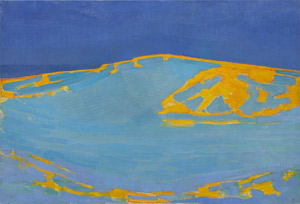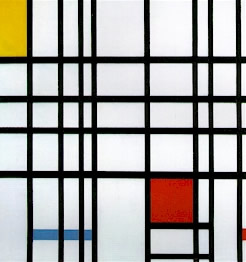9.12.25 — Abstraction as Experiment
To pick up from last time on weaving and abstraction, that opening tells the story pretty well all by itself. Sophie Taeuber-Arp was a painter, puppeteer, and performance artist, while Sonia Delaunay was a dressmaker as well. Throw in “personal uniforms” for Andrea Zittel, and painting has become design for art and life.
The exhibition will never be half as coherent again, and its unraveling could be the real narrative of modern art. What, though, holds its threads together? It depends on the weaver.
 The show can hardly claim a history of weaving, through millennia of human experience. Neither does it ask why Modernism adopted weaving and what that changed. Nor does it tell of weaving’s growing claim on art today. The few exceptions, like Zittel, seem like fortunate mistakes. Nor, too, does it present weaving as “women’s work,” given at last its due. Restricting things to women would be a shame, but that still leaves the question of who makes it through the door.
The show can hardly claim a history of weaving, through millennia of human experience. Neither does it ask why Modernism adopted weaving and what that changed. Nor does it tell of weaving’s growing claim on art today. The few exceptions, like Zittel, seem like fortunate mistakes. Nor, too, does it present weaving as “women’s work,” given at last its due. Restricting things to women would be a shame, but that still leaves the question of who makes it through the door.
The Modern does not present weaving as a particular practice. A large last room leaps from fabric to basket weaving—and from delicate materials to sculptural mass. Martin Puryear cultivates smooth surfaces with a vengeance. Basketry also sacrifices abstraction to functionality and human form. The show does not so much as stick to weaving. Painters include Jack Whitten, the African American, his only weave the cuts of his razor through thick oil.
Perhaps the only weave that matters is the weave of history. Or could it be the rectilinear weave of geometric abstraction? One sees it in the visually charged surfaces of Agnes Martin or Jeffrey Gibson with their debts to Minimalism and to Native American rituals. Right at the start comes Fire in the Evening, oil on cardboard by Paul Klee. And the greatest unraveling comes from Ed Rossbach, whose lace and bleached cotton seem to come apart before one’s eyes.
I thought back to Beatriz Milhazes, whose “pattern and decoration” I had seen only just before at the Guggenheim Museum. Surely if anyone has the weave of abstraction at its wildest, she does. Its patterned circles and the symbols they contain evoke the rhythms and colors that she knows so well from Brazil, where they enter the movements of bossa nova, the Carnival in Rio Tropicália, or just daily life. Her materials came to her from home as well, including shopping bags, chocolate, and candy wrappers. Woven textures enter her work quite naturally, as she layers acrylic on plastic as a medium for transfer to be peeled away. And yet it is only paint, through September 7.
I thought back, too, to an artist whose weave I had seen just days before in Tribeca and again amid the weavers at MoMA, Ellen Lesperance at Derek Eller through May 24. Her fine grid takes on imagery from the changing density of fabric and paint alone. It may hint at faces, totems, or the artist’s hand. It may never reach the edge of her paper, as if set against the sky. But then abstraction is still an experiment.
Read more, now in a feature-length article on this site.

